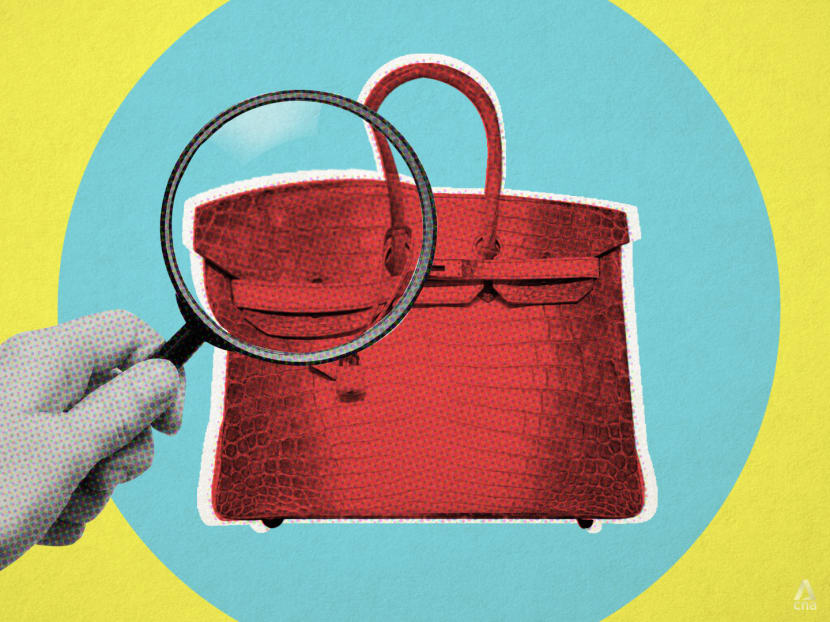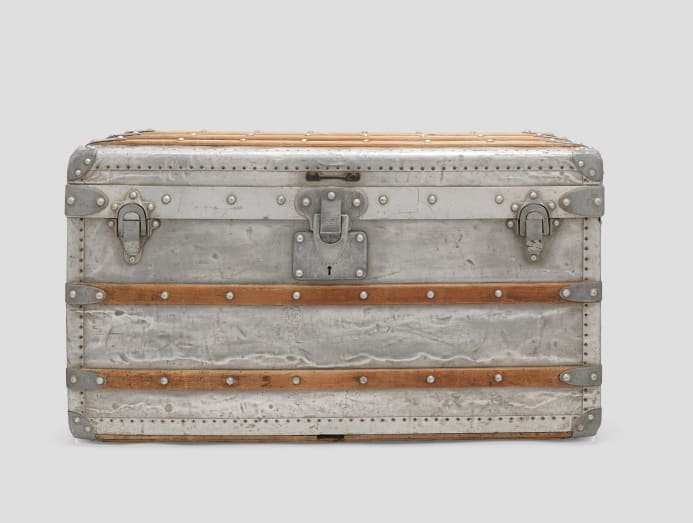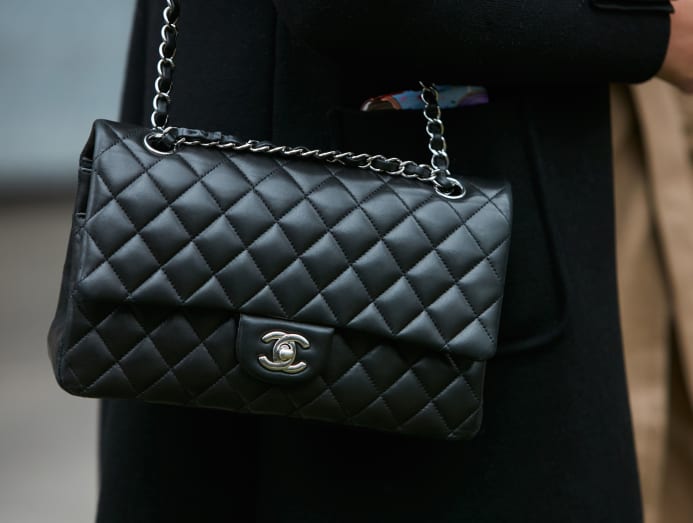Buying second-hand luxury goods? Fakes are rampant, so buyer beware
Advertisement
Obsessions
Buying 2nd-hand luxury goods? Fakes are rampant, then heir-apparent beware
Spending on second-hand luxury items has soared in the last couple of years, only in this burgeoning environment, fakes have proliferated. At present, technology is aiding human authenticators in their quest to thwart counterfeiters.

Spending on second-manus luxury appurtenances climbed from £20 billion (S$36.5 billion) in 2022 to £28 billion in 2020, co-ordinate to Bain, outpacing growth in the overall luxury goods market by a significant margin. (Fine art: Jasper Loh)
Graham Wetzbarger knows what faux tastes like. "Tiffany & Co counterfeits can be coated in aluminium. If you taste it, it's like a soda can, it has a metallic taste that sterling silver doesn't have," he explained.
Wetzbarger, a US-based luxury goods expert and former chief authenticator at consignment site The RealReal, is a house believer that the art of validating a luxury object, be it a work of art or a sneaker, relies on the employ of multiple senses. Although, he admits, taste is very rarely used. "You odor a lot; there is a lot of gum in counterfeits."
Spending on 2nd-hand luxury appurtenances climbed from £20 billion (S$36.5 billion) in 2022 to £28 billion in 2020, co-ordinate to Bain, outpacing growth in the overall luxury appurtenances market past a meaning margin. Online marketplaces and consignment sites including The RealReal and Vestiaire Commonage have made it equally easy to buy and sell second-hand as new – would-exist shoppers no longer take to spend hours trawling bricks-and-mortar consignments stores in search of a coveted bag or clothes.
In this burgeoning environment, fakes have proliferated. Fashion archivist Greg Chester of 1 of a Kind in London says handbag counterfeiters have go then skilled that the store has started to avoid the category altogether. "It'due south not worth the take chances for united states," he said. The RealReal has previously been accused of failing to spot fakes.

Human authenticators are expensive, and tech-powered solutions designed to meliorate – and perhaps ultimately replace them – continue to evolve. In April, LVMH, together with Prada and Richemont-owned Cartier, launched Aureola Blockchain Consortium, a global platform that gives unique digital identities to products, allowing customers to ensure their purchase is the real thing. Hallmark company Entrupy claims a 99.1 per cent accuracy rate later on grooming its image-recognition technology on a self-congenital database of hundreds of thousands of items.
These systems are however in their infancy however. Paradigm-recognition technology needs to be trained on databases of images that are yet being built. Humans are needed to ensure that the visual references fed to the auto are of genuine products.
"Counterfeiters will spend 99 per cent of their time on the exterior of an item to fool the heart, then it's when you go to the guts of the pieces that you start to run into errors." – Graham Wetzbarger
Blockchain, on the other hand, is usually practical at the source, when a product is first created. When applied to vintage products, the items need to be certified first, bringing united states of america back to homo authenticators. For the nigh office, industry professionals view technology as a helpful add-on to a job destined to remain largely human-based for the foreseeable future. "It'due south however a easily-heavy skill," said Wetzbarger. "Xc-plus per cent of the entire industry is human being."
Back to taste, odor and touch it is. When a trunk fabricated of a very unusual metal arrived at Christie's in 2018, Rachel Koffsky, the auction business firm's senior specialist for handbags and accessories, had a feeling it could exist a rare Louis Vuitton piece from the end of the 19th century, fabricated of aluminium. At the time, only one was known to still exist, stored at the Louis Vuitton Foundation in Paris. Seeking scientific confirmation, Koffsky brought the trunk to the National History Museum, where information technology was analysed in a basement lab.

"The trunks that were made in the late 19th century were created for explorers travelling beyond the earth, and they needed to be very lightweight. Aluminium had simply been invented and information technology was a very expensive material, known as the white gold of Napoleon," she explained. "Making certain that information technology was aluminium was critical to ensure that this was the historic piece that nosotros had a feeling that it was going to be." The trunk sold at auction for £162,500 in December 2018.
Details such equally where the manufacturing label and make label are positioned, as well as the structure of the garment itself and, in the case of a Chanel bag, the number of stitches between two quilted sections, tin can assist authenticate an detail. "It'south like learning a linguistic communication," said Chester, who keeps detailed timelines for each brand, recording details such as changes in finishing techniques or manufacturing labels. "Once you have dealt with certain designers for and so long if something doesn't expect correct it sticks out like a sore thumb."
Counterfeiters brand a turn a profit by selling cheaply made items at inflated prices, and so finishing techniques are where they oftentimes fall brusk of the real thing. For both Chester and Wetzbarger, turning a garment inside out is essential. "Counterfeiters will spend 99 per cent of their time on the exterior of an detail to fool the eye, and then it's when you lot get to the guts of the pieces that you start to see errors," said Wetzbarger.
Hardware elements such as buttons, studs and fasteners are besides primal indicators. When it comes to zippers, for example, luxury brands rarely use Japanese make YKK, the world'south largest zipper manufacturer past sales, and instead opt for Riri or Lampo zippers, which Wetzbarger calls the BMW and Mercedes of zippers. Anything that is designed to meliorate direction and inventory control, including serialisation numbers, engagement stamps or fabrication tags, tin can exist leveraged past authenticators to trace the style and appointment of a garment. "All of those itchy things against your sides that a lot of people terminate up cutting out – that makes our job harder," said Wetzbarger.

Luxury authenticators come from a variety of backgrounds and larn much of the trade through direct feel, shadowing other authenticators, as in that location is no formal path into the field. Wetzbarger says many of his best recruits were previously luxury sales assistants who had already been trained to spot and appreciate craftsmanship, often by brands themselves.
Relying on seasoned authenticators to teach the trade to newcomers might have worked when 2nd-hand luxury was a niche market simply, as the sector continues to expand and attract new players, the demand for skilled authenticators has far surpassed availability.
"It's like learning a linguistic communication. Once y'all have dealt with sure designers for then long if something doesn't await right it sticks out like a sore thumb." – Greg Chester
Wetzbarger says that basic training can exist washed in vi months, only it takes a couple of years of autonomous work for an authenticator to be considered an practiced. He laments the lack of a merchandise organisation or a third-party authenticator social club that could provide a shared industry standard.
"Companies are all grooming their own armies of authenticators considering everyone is fighting for market place share," he said. "There are industry standards, but they are not really [formally] agreed upon."
Solving these issues is critical for the 2d-manus luxury market place's success, says Bain partner Claudia D'Arpizio who, despite the promise of blockchain, sees humans remaining at the core of the profession. "You have to have the homo touch there."
By Annachiara Biondi © 2022 The Financial Times
Source: Financial Times/ds
Contempo Searches
Trending Topics
Source: https://cnalifestyle.channelnewsasia.com/obsessions/luxury-goods-fake-authentic-blockchain-technology-287536

0 Response to "Buying second-hand luxury goods? Fakes are rampant, so buyer beware"
Post a Comment